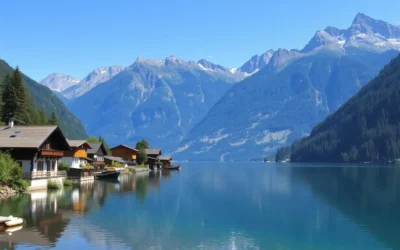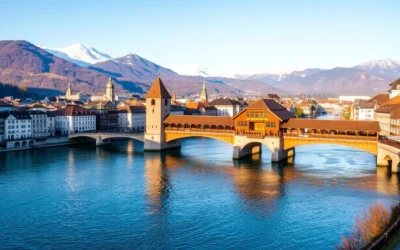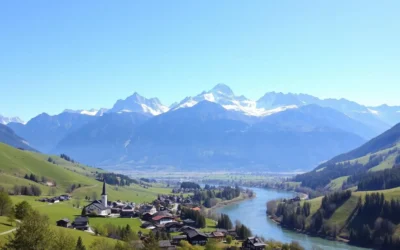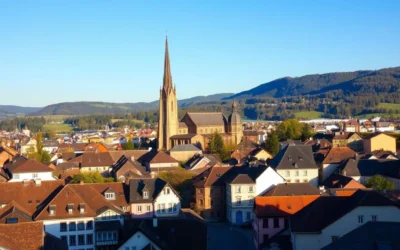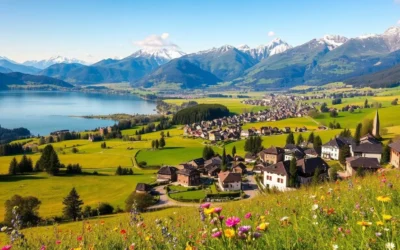✓ Accommodations✓ Flights✓ Rental Cars✓ Tours & Activities
Switzerland is known for its unique blend of cultures, and its language spoken reflects this diversity. With four national language options, this Alpine country offers a fascinating mix of linguistic traditions. German, French, Italian, and Romansh are all recognized as official languages, each playing a vital role in shaping Swiss identity.
German is the most prevalent, with over 60% of the population speaking it daily. Swiss German, a distinct dialect, is particularly popular in everyday conversations. French and Italian also hold significant importance, especially in specific regions. Romansh, though less common, remains a cherished part of the country’s heritage.
This multilingual environment enriches daily life, from workplace interactions to cultural exchanges. Understanding these language dynamics offers a deeper appreciation of Switzerland’s unique charm.
Overview of Switzerland’s Language Heritage
The linguistic landscape of this Alpine nation is shaped by centuries of cultural exchange. Its rich heritage reflects a blend of historical influences and modern practices. Understanding this evolution offers insight into the country’s unique identity.
Historical Evolution
The roots of its diverse dialects trace back to ancient migrations. German was introduced during the Middle Ages, while French gained prominence in the 15th century. Italian became dominant in the southern regions by the 16th century. These languages evolved alongside local traditions, creating distinct regional identities.
Romansh, though less common, has deep historical ties. It remains a cherished part of the cultural fabric, especially in the trilingual Canton of Grisons. Over time, these languages have coexisted, shaping the nation’s multilingual character.
Modern Multilingualism
Today, the country thrives as a hub of linguistic diversity. German is the most widely spoken, with over 60% of the population using it daily. French and Italian also hold significant roles, particularly in their respective regions. Romansh, while spoken by a smaller group, is recognized as an official language, reflecting its cultural importance.
Modern policies ensure harmony among language speakers. For instance, federal documents are primarily written in German, with French and Italian also represented. This balance fosters unity while preserving regional identities. The persistence of local dialects further enriches everyday communication.
Switzerland: Official and widely spoken languages
The country’s linguistic framework is rooted in its federal constitution. This legal foundation ensures that multiple dialects are recognized and protected. Understanding this system helps you appreciate how the population maintains its rich cultural heritage.
National Language Recognition
Legal recognition of dialects is a cornerstone of the country’s identity. The federal constitution designates four national options, each with its own historical and cultural significance. German, French, Italian, and Romansh are all formally acknowledged, reflecting the diversity of the population.
For example, Romansh was recognized as an official regional option in 1938, highlighting its cultural importance. This legal support ensures that even smaller communities can preserve their unique traditions.
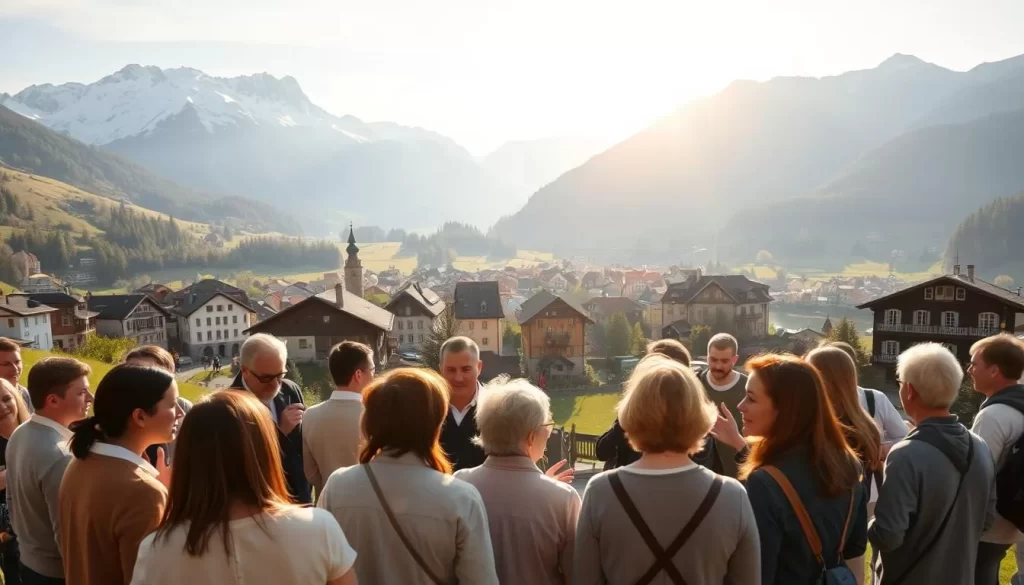
Regional Language Distribution
The population’s linguistic practices vary significantly across regions. German is the most widely used, with over 60% of people speaking it daily. French is dominant in the western areas, while Italian is prevalent in the south.
Romansh, though spoken by less than 1% of the population, remains a vital part of the cultural fabric in certain cantons. This regional diversity is a testament to the country’s commitment to preserving its heritage.
| Region | Primary Language | Percentage of Population |
|---|---|---|
| German-Speaking Cantons | German | 60%-65% |
| French-Speaking Cantons | French | 20%-25% |
| Italian-Speaking Cantons | Italian | 8%-10% |
| Romansh-Speaking Areas | Romansh | 0.5% |
This table illustrates how different regions prioritize specific dialects. It also shows how the population adapts to these linguistic practices in daily life.
Swiss German: A Closer Look at Dialect Diversity
Swiss German stands out as a vibrant example of linguistic diversity, reflecting the unique cultural fabric of its regions. This dialect is not a single language but a collection of Alemannic variations spoken across different cantons and cities.
Variations Across Cantons
In cities like Zurich and Basel, Swiss German takes on distinct forms. Each region has its own pronunciation, vocabulary, and idiomatic expressions. For example, the word for “kitchen cupboard” might be “Chuchichäschtli” in one area but slightly different in another.
These regional differences are shaped by historical influences and local traditions. In some areas, you’ll notice subtle hints of french italian vocabulary, adding another layer to the dialect’s richness.
Transition to Standard German
While Swiss German dominates everyday conversations, Standard German is used in formal settings. Schools, official documents, and media rely on this standardized form.
Many in the swiss population practice diglossia, effortlessly switching between dialects and the standard form. This flexibility highlights the country’s linguistic adaptability.
- Swiss German is primarily a spoken language, used in local radio and TV programs.
- Standard German is reserved for writing and formal communication.
- Unique words like “Znüni” (mid-morning snack) showcase the dialect’s charm.
Understanding these nuances helps you appreciate the complexity of Swiss German and its role in shaping regional identities.
Exploring French in the Swiss Context
French in Switzerland offers a unique twist on the language, blending local traditions with global influences. This dialect is not just a spoken language but a reflection of the region’s rich cultural heritage. Over 22.9% of the population uses it daily, making it a vital part of the country’s multilingualism.
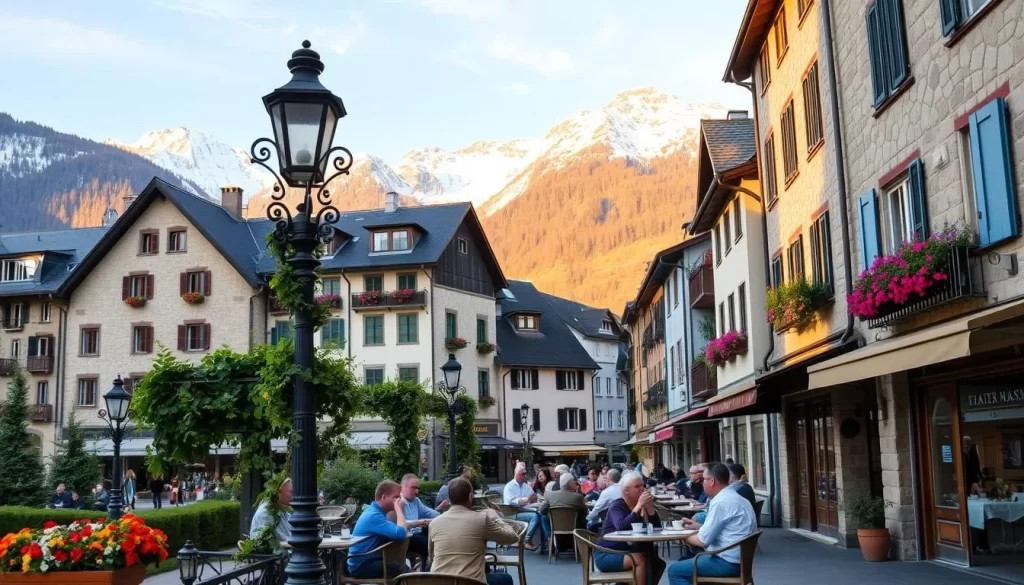
Distinctive Lexical Features
Swiss French stands out with its unique vocabulary and expressions. For example, numbers like “septante” (70) and “nonante” (90) differ from Standard French. These terms add a local flavor to everyday conversations.
In this region, breakfast is called “déjeuner,” lunch is “dȋner,” and dinner is “souper.” These distinctions highlight how Swiss French preserves its identity while adapting to local customs.
Pronunciation also sets it apart. Swiss French speakers often enunciate final consonants more clearly, creating a distinct rhythm. This clarity makes it easier for learners to understand.
Compared to Standard German, Swiss French offers a softer, more melodic tone. This contrast enriches the country’s linguistic diversity, making it a fascinating study for language enthusiasts.
Real-life examples, like the use of “natel” for “mobile phone,” showcase how Swiss French integrates seamlessly into daily life. These terms reflect the region’s ability to blend tradition with modernity.
Italian and Romansh: Voices from the South and East
In the southern and eastern regions, Italian and Romansh add distinct flavors to the linguistic tapestry. These languages, though less widespread, play a crucial role in shaping local identities. Their preservation reflects the commitment to cultural diversity.
Comparing Swiss Italian with Standard Italian
Swiss Italian, spoken primarily in the canton of Ticino, differs subtly from Standard Italian. Vocabulary and pronunciation vary, influenced by local dialects. For example, the word for “bus” is “autopostale” in Swiss Italian, while it’s “autobus” in Standard Italian.
These differences highlight the adaptability of language in different regions. A typical swiss person in Ticino might switch between dialects effortlessly, showcasing the region’s linguistic richness.
The Preservation of Romansh
Romansh, spoken by around 40,000 native speakers, is a vital part of the cultural heritage in the canton of Grisons. Despite its small speaker base, efforts to preserve it are robust. Schools and media in the region actively promote its use.
One challenge is its geographical division into non-adjacent parts, making unified preservation efforts difficult. However, initiatives like the standardized variety Rumantsch Grischun, introduced in 1982, aim to bridge these gaps.
Translation plays a key role in keeping Romansh alive. Local literature and official documents are often translated into this language, ensuring its relevance in modern times.
Everyday Multilingualism in Swiss Society
Public spaces are a testament to the seamless integration of multiple languages. From supermarkets to train stations, you’ll notice how multilingualism shapes daily interactions. This reflects the country’s rich culture and commitment to inclusivity.

Language Use in Public Services
Public services are designed to cater to diverse linguistic needs. For example, announcements in trains and buses are often made in German, French, and Italian. This ensures everyone feels included, regardless of their primary language.
Multilingual signage is another common feature. In supermarkets, labels and instructions are available in multiple languages. This not only aids communication but also celebrates the nation’s culture of diversity.
Even minority languages play a role in shaping the social area. In regions like Graubünden, Romansh is used in official documents and public announcements. This highlights the importance of preserving linguistic heritage.
For more insights into how multilingualism continues to evolve, check out this detailed report.
Cultural Impact of Language Diversity in Switzerland
Every region tells its own story through the words it speaks. The diversity of dialects here isn’t just about communication—it’s a reflection of unique traditions and identities. From the Alps to the cities, language shapes how people live, celebrate, and connect.
Regional Identity and Traditions
In French-speaking areas, local customs are deeply tied to the language. For example, festivals in Geneva often feature traditional songs and phrases that highlight the region’s heritage. These events show how vocabulary preserves cultural practices over time.
In German-speaking regions, dialects like Swiss German play a key role in daily life. Words like “Znüni” (mid-morning snack) aren’t just terms—they’re part of a shared identity. This connection between language and culture is what makes each area unique.
- Language reinforces regional pride and unity.
- Vocabulary evolves to reflect local customs and traditions.
- Time-honored practices are passed down through generations.
French-speaking communities, for instance, often use distinct terms for meals. Breakfast is “déjeuner,” lunch is “dȋner,” and dinner is “souper.” These differences highlight how language adapts to local lifestyles.
Understanding these nuances helps you appreciate the cultural mosaic of this nation. For more insights, explore this detailed report on linguistic diversity.
Business and Communication Across Language Borders
Business thrives in a multilingual environment, where communication bridges cultural divides. In a globalized world, companies that embrace language diversity gain a competitive edge. This is especially true in regions where multiple dialects coexist, fostering innovation and collaboration.
Multilingual Workforce Advantages
Having a workforce fluent in multiple languages offers strategic benefits. For instance, international banks and organizations often rely on teams that can navigate cross-border communication with ease. This ensures smoother negotiations and stronger partnerships.
Take the chocolate industry as an example. Swiss brands like Lindt and Toblerone leverage their multilingual expertise to market products globally. Their ability to adapt messaging across languages has made them household names.
Here’s how companies benefit from a multilingual workforce:
- Improved customer relations through tailored communication.
- Enhanced collaboration within diverse teams.
- Greater adaptability in global markets.
In this way, language diversity becomes a cornerstone of business success. It allows companies to connect with clients and partners on a deeper level, fostering trust and loyalty.
| Industry | Language Skills Utilized | Outcome |
|---|---|---|
| Banking | German, French, Italian | Streamlined cross-border transactions |
| Chocolate Production | English, German, French | Global brand recognition |
| Tourism | Multiple dialects | Enhanced visitor experience |
Effective language management is key to leveraging these advantages. By investing in multilingual training, companies can empower their teams to excel in diverse environments. This not only boosts productivity but also strengthens the organization’s global presence.
As one expert puts it,
“Language is the bridge that connects ideas, cultures, and opportunities.”
This principle is at the heart of successful international business strategies.
For more insights into how multilingualism shapes global industries, explore this detailed resource.
Navigating Swiss Dialects and Local Vernaculars
Exploring the rich tapestry of local expressions reveals the heart of Swiss linguistic diversity. Each region boasts its own unique phrases and idioms, adding charm to everyday conversations. These expressions are not just words—they’re a reflection of cultural identity and heritage.
Local Expressions and Idioms
In the German-speaking regions, the Alemannic dialect dominates daily life. Phrases like “Chuchichäschtli” (kitchen cupboard) are more than just vocabulary—they’re a nod to local traditions. These idioms vary across cantons, offering a glimpse into the different dialect variations within the world of Swiss German.
French-speaking areas have their own unique expressions. For example, “septante” and “nonante” are used instead of “soixante-dix” and “quatre-vingt-dix” in Standard French. These terms highlight how language adapts to regional customs.
For an Italian speaker, navigating mixed-language areas can be an adventure. In Ticino, words like “autopostale” (bus) replace Standard Italian terms, showcasing the region’s linguistic flair. This adaptability is a testament to the country’s multilingual spirit.
Here are some examples of local expressions that add flavor to Swiss dialects:
- German: “Znüni” (mid-morning snack)
- French: “Souper” (dinner)
- Italian: “Autopostale” (bus)
Understanding these nuances helps you appreciate the rich tapestry of local vernaculars. For more insights, explore this detailed resource on Swiss linguistic diversity.
Language Learning Tips for Your Swiss Journey
Mastering local dialects can transform your travel experience in this multilingual country. Whether you’re exploring the German-speaking cantons or crossing the border into French-speaking regions, knowing a few key phrases can make a big difference. Understanding the history behind these dialects also helps you connect more deeply with the culture.
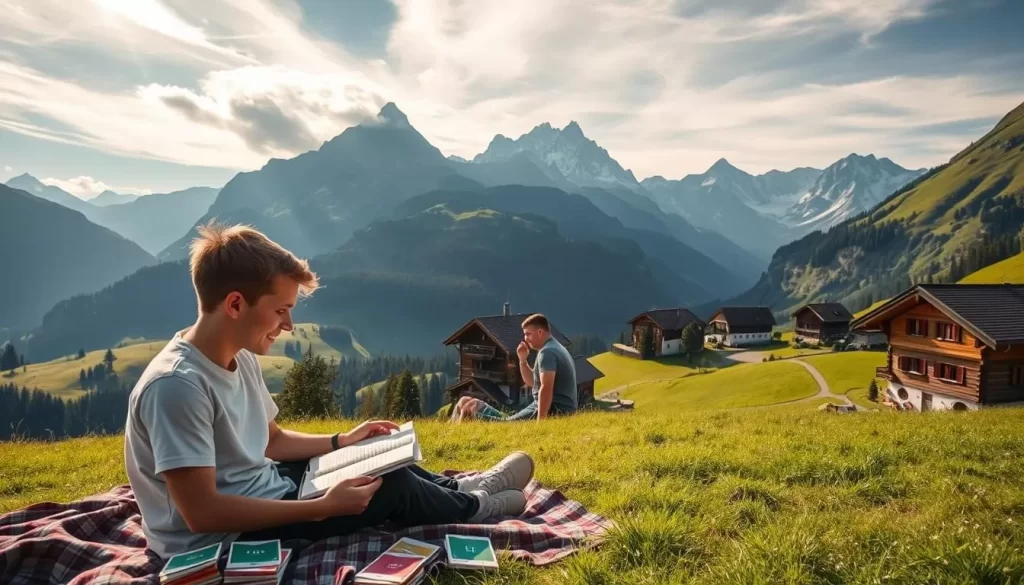
Practical Language Skills
Start by focusing on essential phrases for everyday interactions. In the German-speaking part country, words like “Grüezi” (hello) and “Danke” (thank you) are invaluable. If you’re heading to the French-speaking regions, “Bonjour” and “Merci” will go a long way.
Learning a bit of the local history can also enhance your communication. For example, knowing why certain dialects vary across regions can help you appreciate the nuances of each person speak.
Here are some practical tips to improve your language skills:
- Practice greetings and common phrases daily.
- Listen to local radio or podcasts to get used to accents.
- Engage in conversations with locals to build confidence.
Useful Resources for Travelers
There are plenty of tools to help you learn before your trip. Apps like Duolingo and Babbel offer courses in German, French, and Italian. These are perfect for building a basic vocabulary.
If you’re planning to visit multiple part country, consider enrolling in a local language course. Cities like Basel and Geneva offer affordable or even free classes for travelers.
For a deeper dive into Swiss German, check out this detailed guide. It’s packed with tips to help you master the dialect quickly.
| Resource | Language | Best For |
|---|---|---|
| Duolingo | German, French, Italian | Beginners |
| Babbel | German, French, Italian | Intermediate Learners |
| Local Courses | Swiss German, French | Advanced Practice |
“Language is the key to unlocking a deeper connection with the places you visit.”
By investing time in learning the local dialects, you’ll not only navigate the border regions with ease but also create meaningful interactions with the people you meet. This approach ensures your journey is both enriching and memorable.
Conclusion
The diversity of languages in this Alpine nation is a cornerstone of its identity. With four national options, the state ensures each dialect thrives. German, French, Italian, and Romansh coexist, reflecting a rich cultural heritage.
This linguistic variety shapes daily life, from business to education. The number of speakers varies by region, yet all contribute to the nation’s unity. Policies promote multilingualism, fostering respect for local traditions.
Exploring this diversity offers a deeper understanding of the country’s unique charm. Whether you’re visiting or working here, engaging with the local culture enriches your experience. Discover more about this fascinating state and its linguistic landscape here.
The above is subject to change.
Check back often to TRAVEL.COM for the latest travel tips and deals.

